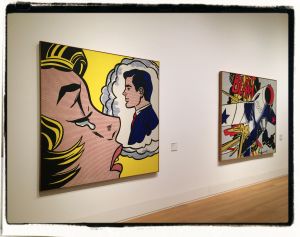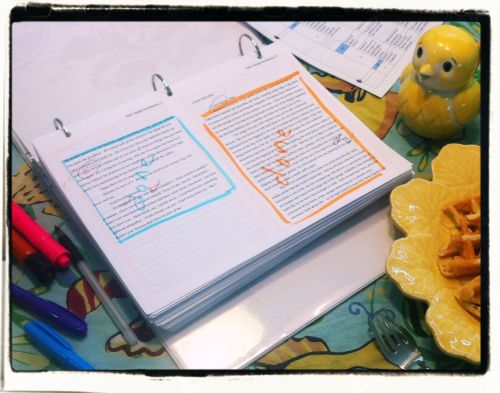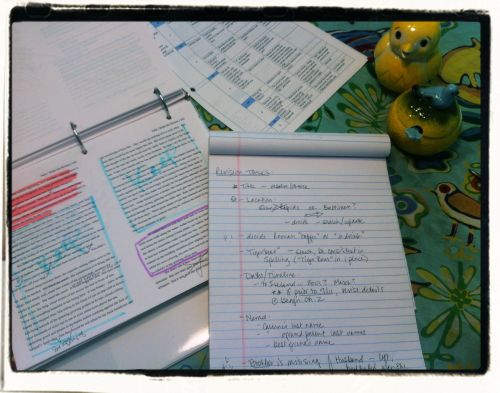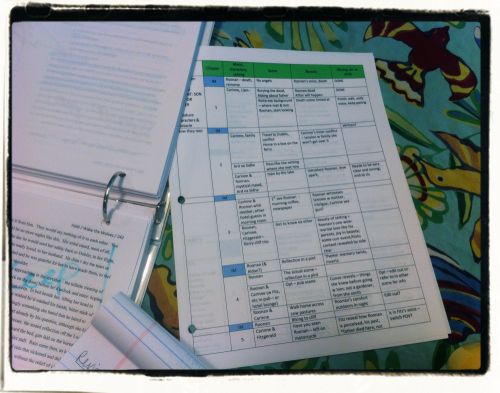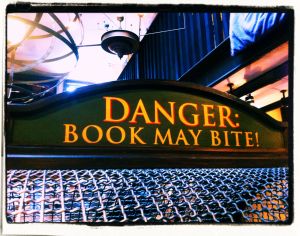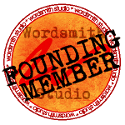
Editing manuscript for Wake, poolside, during summer months off. Can’t argue with that. c. Elissa Field
One of the biggest jobs I addressed in novel revisions over the winter had to do with one of my three main characters. She was originally the main POV, but I wasn’t excited about her voice. Not helpful: I thought of her as relatively unlikeable: sullen, and not the way Jane Austen used to fix by saying, “It’s just that she has her head in a book.” No. My girl, Carinne, was broody.
I’ve written about my challenges with her twice before. You don’t need to read these now — they’re long-ish and I’ll give explanation, below — but here are the prior posts:
Is this Character the Best POV?
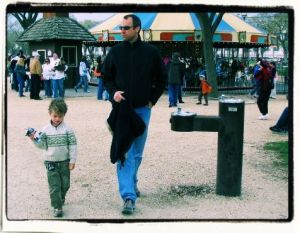
Father and son. copyright Elissa Field
That last link shares a tool I used to evaluate the stakes for my characters — which revealed what I had already suspected: weakness in Carinne as main character was hint that she is not really the center of the conflict.
In early versions, it was natural for Carinne to be the main POV as she fell in love with the other main character and tells the story (in present and past) after he is reported to be dead. Her POV allows his life/death to remain in question.
But in revisions over several months, much of what I’ve written has been from other points of view (Michael Roonan, his best friend, and his son, Liam). I set aside the actual WIP and went “off road” into the internal and external motivation, the characters’ voices and backstories and fears and desires, the setting. The male MC, Roonan, had a famous motorcycle racer for a father, and the voice of Roonan came alive the more time I spent thinking about that. (Here’s a bit of draft-work I shared from Roonan’s perspective)
As Roonan’s voice comes alive in new material, it allows the 3rd person POV to not be centered on Carinne but alternate between characters. The fix: Carinne is not “flat” when seen through Roonan’s eyes — and the story is stronger for being centered on its conflict.

c.Elissa Field
It’s Not You, It’s Her
Going to the other posts listed above, one of my struggles with Carinne was that “challenge of the character most like myself.” While Carinne is not an autobiographical character, I still have that authorial “blind spot” and resistance in portraying her.
I called her broody up above and that’s the “character like myself” obstacle: my own self-consciousness about never wanting to be melodramatic or complain gets in my way when expressing Carinne’s crisis. In hard times, my family’s attitude is, “Well get to work and solve your problem.” But, uh — that attitude isn’t helpful when you’re a character depicting your reaction to an inciting event and wrestling your way through a book-length conflict. If authors toughened up and spared the emotion, we’d have very short books.
Following advice in those posts, I had to create authorial distance to see Carinne as outside myself, and I had to be unapologetic. When Carinne fights with her mom in an early chapter, I can’t be thinking, “I don’t want to write about fighting with a mom. What if my mom thinks I wrote it about her?” Because — well, yeah, I did, in the sense that I used the knowledge of how uncomfortable it is to be at odds with your mom and that it was a sign to the reader that the mother knew something more was going wrong with Carinne. As I occupy and own that truth, the scene I first envisioned loses thinness and takes on the resonance I intended. If you read yesterday’s post, the “something more going wrong” is the revised backstory that has me so busy right now. In getting to know Carinne outside myself, a much clearer backstory arose, empowering her motivation throughout the book — and also helping me see her as a character distinct from my own experience. There was no simple trick to doing that, other than continually asking myself, “Why would she do this?”
Likewise, in answering that question, I had to step fully into — and not back away from or deny or justify — the choices Carinne makes. I had to let her make bad choices — resulting in a memorable story — rather than back away and try to say, “She didn’t really do that.” Oh, yeah, she did that! She was bad, and we’re having fun reading the consequences. Um. I mean, sorry about that, Carinne. When I fully owned what she had done and went deep into why she would do it, the story took over.
Now to Integrate Those Changes
At this point, integrating these changes into the WIP seems to resolve the issues with this character by writing Roonan more fully, seeing Carinne from his perspective and having Carinne own her experience. As the story gets going, it now seems clear that she has a good reason for her broodiness: She’s raising a baby by herself who was fathered by a man she last saw when he saved her from being shot, and feels isolated when everyone thinks she should get over it.
My remaining insecurity in revising Carinne will be that she is the voice of the opening chapter, which carries so much weight. That is, the first page is a disembodied internal monologue in Roonan’s voice, hinting at death and guilt, then the chapter opens with Carinne watching their son in the backyard, and responding to the inciting incident of the son questioning his father’s absence.
Beta readers have liked the opening, but I’ll still be jumpy about it as I finish revisions and I’m sure I’ll keep pushing myself to get her voice right. (What was the theme yesterday? “Sometimes the Work is Messy” and, “Danger – Book May Bite.” )
* * * * *
Daredevil: Sharing a Bit of Today’s Work
I did something brave the other day. I submitted an excerpt of chapter one for consideration by a lit mag that publishes first chapters. (If by any wild chance you happen to be a reader or editor at said magazine-that-publishes-first-chapters, can I say just how fabulous you look?)
I won’t post the opening, to avoid negating “first pub” rights, but I wanted to share a bit of the work I’ve been revising. So here is a short bit of Carinne’s conflict from the end of the chapter, an excerpt from my novel in progress, Wake:
She sees herself already, weak as she will be later, when Liam has fallen asleep – not in his bed, as other mothers would be so good to do, but stretched out long like a dog across her bed, sighing in his sleep as if it were such work to be here on this earth as a little boy, such relief those hours left alone to sleep, return to wherever it is he came from. Wherever it is children come from and the dead return to — and she won’t be able to fight it, that urge, once again to hunt for Michael Roonan. Search websites and news footage and maps shot from space, pictures so accurate a man could be standing in that shadow beneath a cloud, looking up to wave.
Search until sleep took over. Never to find.
As if it had never happened.
I ran, she remembered. Ran. Escaped the agent dispatched from Dublin Centre, escaped the gardai at the rotating brass doors at the front of the hotel, slipping, ankle twisting. Everything moved. Rushing cars that might have been standing still. Pavement rushing up to her, blood on her palm as she brushed gravel from her knee. Blood at her wounded shoulder, gauze plastered in a crust to her skin. A tunnel in her shoulder, perfectly-pierced hole raged through by a bullet plucked with stainless tongs. The sound. The sound of that flattened lead bud clanking into a metal pan, tongs rattling behind it. Bullet. Real. Real as a bullet clanking into that metal pan. I was there.
She might have screamed it into the street, turning heads of Dubliners, of footballers anticipating a match, tourists murmuring as they all did, “World Bar, St. James Gate…” Her vision blurred. She stumbled blocks she could not have retraced, voices calling to her in her stumbling rush, blood maybe seeping through the bandage at her shoulder, crazed fear at her eyes – here and there they called out as to an injured animal, “You, there!”
Me there. Over and over they called it out. Me there. I was there.
Tiny bud of infant, even then, swimming its way north. Evidence. There, then.
Here, now. Liam stretched asleep, like a dog at her feet. Given over to it, once again: searching on her laptop into the night. Hunting for Michael Roonan.
“I’m sorry I’ve lost your father,” she whispers. “I’m sorry I have no answers for you.”
If you want to leave constructive feedback, I’d welcome answers to these questions:
- Does the character/action/voice hook you? Do you want to read more?
- Are there any details that work? Is there wording that is confusing?
- If Carinne seems flat to you, what do you feel is missing? If she’s not flat, reassure me if you found her engaging.
Read more about where revisions take me next:
Read this January 2014 post, which continues to share how I push Carinne’s character and explore the perspective of her son, Liam, including a draft excerpt from this same chapter, written from Liam’s perspective: Writing in Process: Using Alternative Voice to Understand Internal Conflict.
* * * * *
What About You?
What challenges do you encounter in writing character, or what approaches do you take to understand their motivations?
I find I’m slow to describe physical appearances — are there certain details you always include or tend to exclude?
I’ve enjoyed connecting with readers about your current writing goals and challenges. If any of this post or the links resonated with you, let me know.
* * * * *
If you like this blog, be sure to subscribe using WordPress’s +follow option, or via email or RSS feed. I love to connect with like-minded readers and writers!
The links embedded in this story:
Other Recent Stories:
Where Else You’ll Find Me:

 Found on Pinterest: Plot Timeline Infographics
Found on Pinterest: Plot Timeline Infographics





